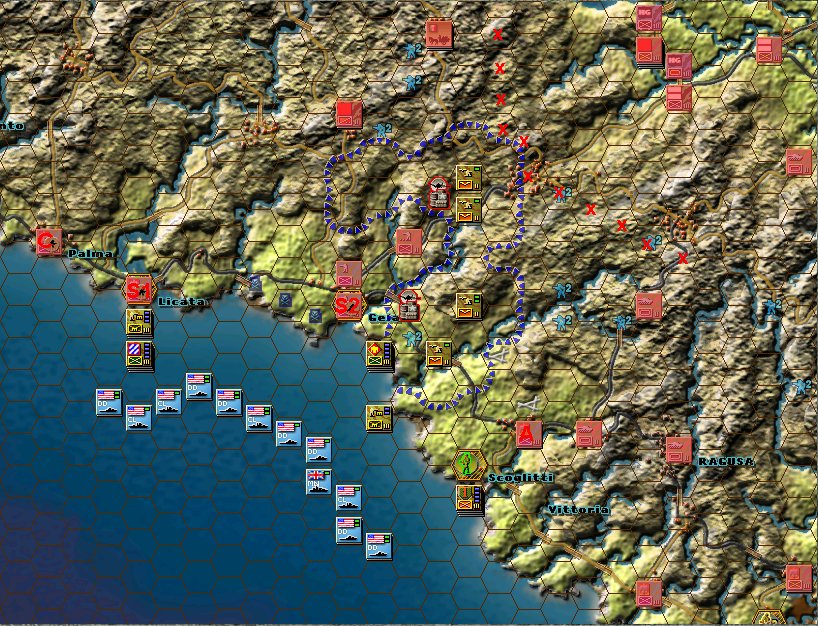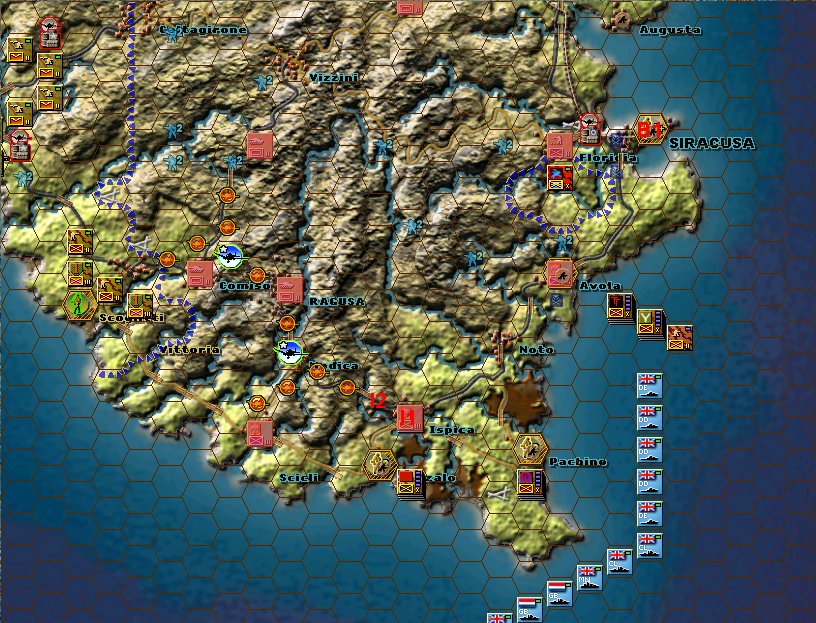
The good news for the US side is that there is nothing that the Axis can do to prevent your forces from getting ashore. Any defenders on the beach are substandard units, manning weak defenses and likely to surrender. Luckily for you, the real defenders of Sicily are not in a position to interfere on the first day of the landings. However, there are some important steps you can take to make the landings go smoothly and to ready yourself for the struggle ahead.

As with all airborne landings in WWII, the actual landing sites are somewhat random. Unless landing casualties are particularly high, your parachute battalions should be able to mount some reasonable attacks on the Italian units in their vicinity, and with any luck, induce them to surrender. The most important objective is to avoid overextension, which would result in Allied controlled territory intersecting with the territory marked on the map by the red ‘x’ lettering. This delineates the surprise radius of Axis units, including the Herman Goring Panzer Division. If you wake them up early, they will pay your airborne battalions an unwelcome visit on Turn 2, whereas left slumbering, they will not awake until Turn 3.
The forces using the eastern sealane comprise most of the US 1st and 45th Infantry divisions, along with supporting units. Since the 18th Regiment of the 1st Infantry doesn’t arrive until Turn 2, and then as a reinforcement at the port of Scoglitti (54,48) it makes sense to land the first two regiments of the 1st Infantry there to secure the port, along with the 1st and 4th Ranger battalions. As a bonus, the Italian units at Point A (56,47) can be attacked at favorable odds and, as they are unsupported substandard units, they have a 70% chance of surrender. In Turn 2, you can use the Ranger battalions to secure the road junction at Comiso (58,47) which will greatly hinder the escape of Italian units caught between your units and those of the British Commonwealth.
The 45th Infantry Division should have the task of securing the port of Gela (58,43). There’s only one weak strongpoint, and it should pose no problem to the assembled naval armada. One point to note is that Cruisers (CA) now get two artillery shifts in combat, so it makes sense to use the Destroyers (DD) to take out strongpoints and reserve the Cruisers for supporting ground combats. Depending on the scatter of the airborne forces, you may be able to combine with them in eliminating defenders behind the beach hexes.
Note that one strongpoint at Palma (40,41), marked C on the map, is out of range of your Destroyers, so save the Monitor and a few Cruisers to make sure of eliminating it.
The most important task of the 3rd Infantry division is to take the port of Licata (43,43). This is the hex at which many reinforcements arrive, and it’s the first US supply source to become active. There should be no problem in disposing of the defenders here, and at Palma (40,41).
If you have inadvertently woken up the defenders in the hinterlands, then you should deploy as much interdiction as possible on the road between them and your forces. If they sleep on, then use any interdiction to slow down the escape of those Italian forces trapped between yourself and the British Commonwealth forces.
The road between Licata (marked S1) and Gela (marked S2) is very important to both supply and the movement of reinforcements. You should deploy your Engineer units to clear this road as soon as possible.
Your most important task on Turn 2 is to consolidate your beachhead and ensure that you make ready to advance in good order. Those forces landing at Gela need to get off the coastal plain and into the better defensive terrain, but without prematurely alerting the HG and other defenders. At least some elements of the 1st Infantry need to go north to help with defense of the bridgehead and the road running through Caltagirone, though obviously Italian defenders need to be rounded up as well.
The defenders of Licata also need to make room around the port, and get themselves into better terrain.
The Commonwealth forces will be relieved to know that their landings will be just as easy as those for the US forces. However, like the US forces, the location of the airborne landing is somewhat variable, and this may affect the choices for the Commonwealth player.

There’s only one point of resistance, Avola (70,47). The strongpoint can easily be eliminated, and the defender is likewise easy enough to dislodge, and may well surrender. The 50th Infantry Division should be more than equal to the task, leaving elements of the 5th Infantry Division to land further north. If any defenders survive, you will probably be able to land your artillery without risk, and use that to finish them off.
The forces here are the 1st(Canadian) Infantry Division and the 51st Infantry Division. I like to land the Canadians at Pozzalo (64,53) and send them west as soon as possible. This will help trap Italians who might otherwise make good their escape, and also help the US forces, who could face early counter-attacks. Send the 51st Infantry north as soon as it lands.
Siracusa (73,43), marked B1, is worth 25 VP per turn to the Axis, so it’s important to capture it as soon as possible. You can’t do this on Turn 1, but you can make sure that the strongpoint is destroyed so that capture on Turn 2 is assured.
Since the strongpoints are so few and so feeble you may well have ships left over after all bombardment tasks are complete. Your cruisers can interdict movement, so the hexes (64,51) and (65,52), marked I1 and I2, are good candidates for this, in order to hinder any retrograde movement by the unit there.
The Commonwealth forces shouldn’t face any real problems on Turn 2, unless they have to try and rescue an errant airborne regiment. Problems on this front come later, is the Germans mount a counter-attack or when the action draws closer to the open terrain in front of Catania.